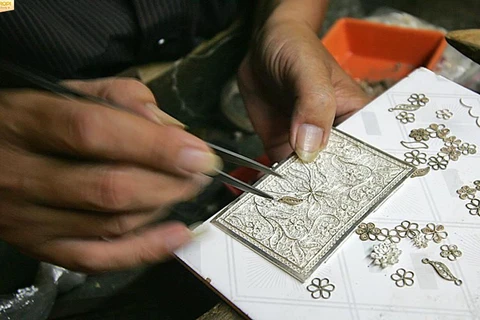Hanoi (VNA) - The handicraft of gold and silver in Chau Khe village in the northern province of Hai Duong originated from the silver ingot casting profession during the reign of King Le Thanh Tong (1460-1497), over 500 years ago.
Located 20 kilometers southwest of Hai Duong city, Chau Khe village is one of Vietnamese Tonkin’s three most renowned gold and silver crafting villages. The other two are Dinh Cong (in Hanoi) and Dong Xam (in Thai Binh province).
According to historical records, the handicraft of gold and silver in Chau Khe originated from the silver ingot casting profession during the reign of King Le Thanh Tong (1460-1497), over 500 years ago.
At that time, Luu Xuan Tin, an imperial officer from Chau Khe village, was entrusted by the king with the task of casting silver ingots for currency in the capital Thang Long (present-day Hanoi). To fulfill his duty, Tin gathered local craftsmen and established a workshop in Dong Cac Ward, Dong Tho Commune, Huu Trac District, Tho Xuong Prefecture (now 58 Hang Bac Street, Hoan Kiem District, Hanoi) to produce gold and silver ingots for currency and for royal palace utensils.
From then on, the gold and silver craft of Chau Khe and Hang Bac Street developed concurrently.
People flocked to the street, forming a residential quarter similar to their hometown and establishing a communal house called Chau Khe, echoing the customs of their native village.
Initially, Luu Xuan Tin’s task was solely to cast silver ingots, gold bars, and coins for domestic trade. However, after the King realized that there were sufficient ingots and bars, Tin was instructed to create jewelry and items exclusively for the king and the royal court.
This laid the groundwork for the emergence of the first gold and silver jewelry craftsmanship in the country.
Several hundred years later, the profession of casting silver ingots was transferred to Hue under the Nguyen Dynasty, yet the majority of artisans from Chau Khe village chose to stay behind.
Initially, they crafted household items such as candle holders and pots, before progressing to fine jewelry like rings, necklaces, gemstone pendants, bracelets, rings, and more intricate pieces.
Through the ebbs and flows of history, there were times when the gold and silver craft in Chau Khe appeared stagnant and on the brink of fading away. Yet, with the onset of the country's period of renewal, the fervor and resolve of Chau Khe's residents and its artisans played a crucial role in revitalizing the craft village, solidifying its reputation and promoting its continued development.
In 2004, Chau Khe was officially recognised by the Hai Duong Provincial People's Committee as the “Gold and Silver Handicraft Village."
Currently, the village comprises nearly 300 households, with approximately 97% of them engaged in traditional gold and silver craftsmanship.
This figure represents a one-third decrease compared to the 1980s as many households shifted their production to Hang Bac, Hanoi, and various other locations across the country.
Driven by market demands for gold and silver products, artisans in the village constantly seek innovation and creativity to produce the best and most beautiful items to meet both domestic and international market requirements.
To preserve and develop the craft village, the People's Committee of Binh Giang District has consistently monitored its development. Various departments and sectors within the district have proposed training programmes and workshops in collaboration with relevant agencies to enhance skills and effectively disseminate information to residents to maintain and develop this traditional craft village.
The district plans to secure funding to improve conditions for households, thereby supporting the sustainability and development of the traditional craft village./.

























